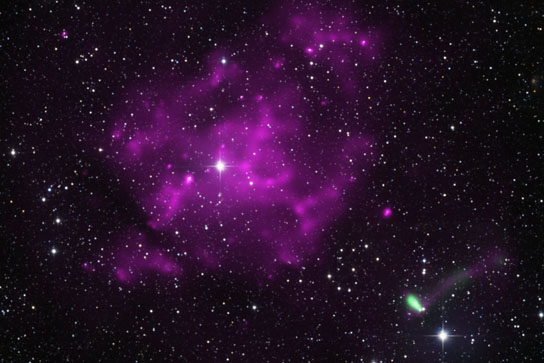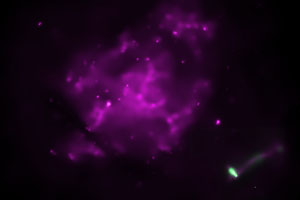Possibly the Fastest Moving Pulsar Ever Detected – Traveling at Roughly 6 Million MPH

Using three different telescopes, scientists found evidence of a pulsar moving at a speed between 5.4 million and 6.5 million miles per hour at a distance of about 30,000 light years away from Earth in the constellation Carina.
The evidence for this potentially record-breaking speed comes, in part, from the features highlighted in this composite image. X-ray observations from Chandra (green) and XMM-Newton (purple) have been combined with infrared data from the 2MASS project and optical data from the Digitized Sky Survey (colored red, green and blue, but appearing in the image as white).
The large area of diffuse X-rays seen by XMM-Newton was produced when a massive star exploded as a supernova, leaving behind a debris field, or supernova remnant known as SNR MSH 11-61A. Shocks waves from the supernova have heated surrounding gas to several million degrees Kelvin, causing the remnant to glow brightly in X-rays.

Optical Image of Igr J11014-6103

X-ray Image of Igr J11014-6103
The Chandra image shown in the inset (“Chandra Close-up”) reveals a comet-shaped X-ray source well outside the boundary of the supernova remnant. This source consists of a point-like object with a long tail trailing behind it for about 3 light years. The bright star nearby and also the one in SNR MSH11-16A are both likely to be foreground stars unrelated to the supernova remnant.
The point-like X-ray source was discovered by the International Gamma-Ray Astrophysics Laboratory, or INTEGRAL, and is called IGR J11014-6103 (or IGR J11014 for short). It may be a rapidly spinning, super-dense star (known as a “pulsar”, a type of neutron star) that was ejected during the explosion. If so, it is racing away from the center of the supernova remnant at millions of miles per hour.
The favored interpretation for the tail of X-ray emission is that a pulsar wind nebula, that is, a “wind” of high-energy particles produced by the pulsar, has been swept behind a bow shock created by the pulsar’s high speed. (A similar case was seen in another object known as PSR B1957+20 .
The elongated emission is pointing towards the center of MSH 11-61A where the pulsar would have been formed, supporting the idea that the Chandra image is of a pulsar wind nebula and its bow shock. Another interesting feature of the Chandra image, also seen with XMM-Newton, is the faint X-ray tail extending to the top-right. The cause of this feature is unknown, but similar tails have been seen from other pulsars that also do not line up with the pulsar’s direction of motion.
| 




